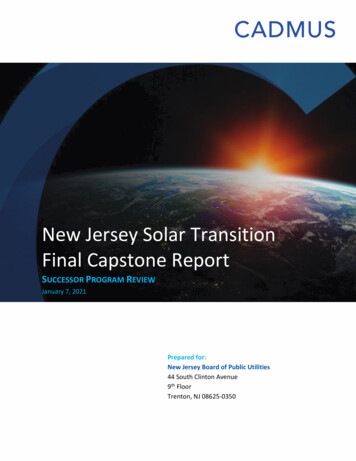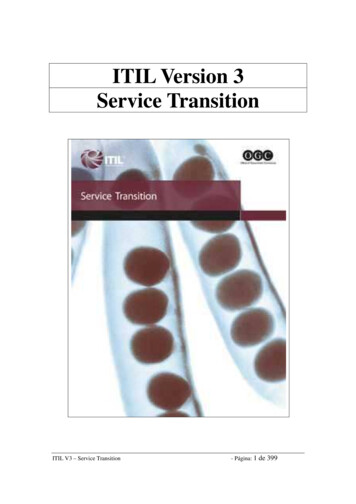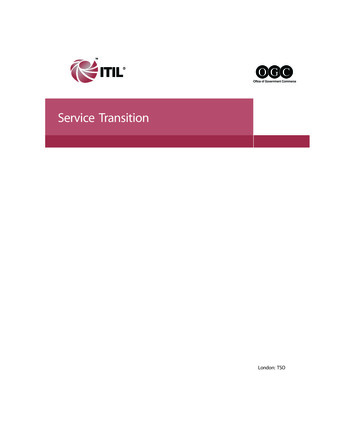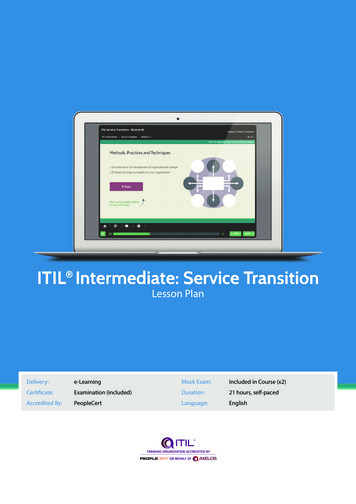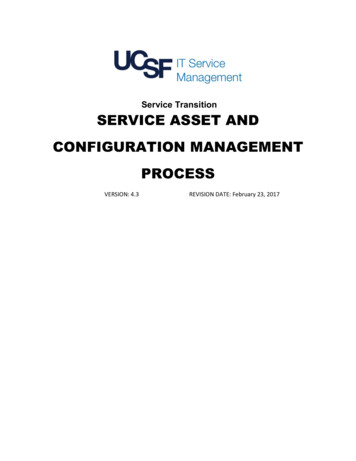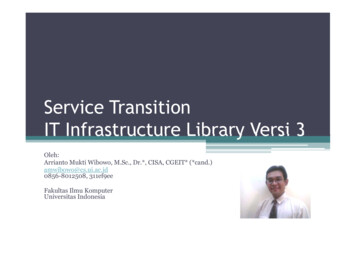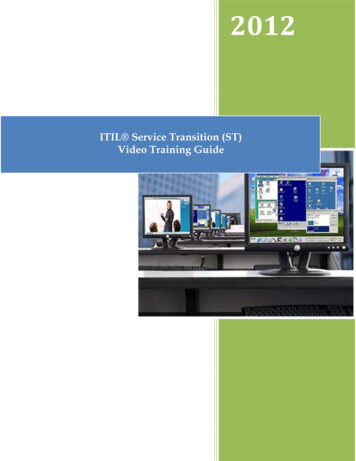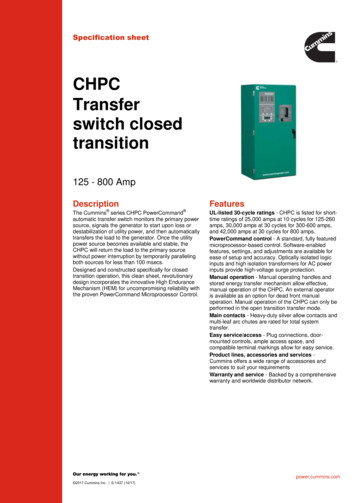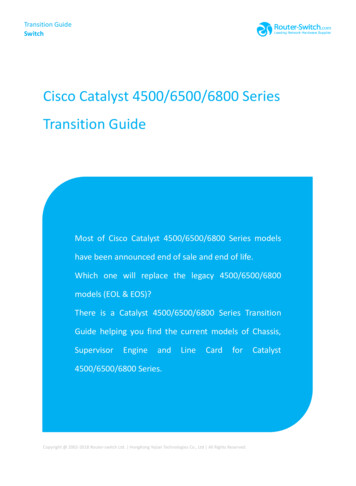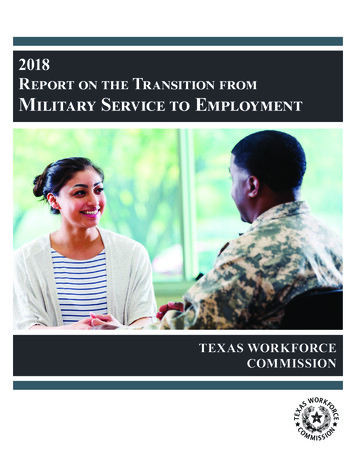
Transcription
2018Report on the Transition fromMilitary Service to EmploymentTEXAS WORKFORCECOMMISSION
ContentsHouse Bill 257 Introduction .2The Texas Workforce Commission’s Commitment to Serving Veterans.3Texas Workforce Commission and Community Partners.3Texas Veterans Leadership Program.4Texas Operation Welcome Home.5College Credit for Heroes.7Top Five Military Occupational Specialties for 2018 .91. Infantryman/Rifleman .102. Health Care Specialist / Hospital Corpsman .113. Motor Transport Operator/ Motor Vehicle Operator/ Petroleum Supply Specialist .134. Human Resources Specialist .165. Unit Supply Specialist/Logistics .171HB 257 Report (08.28.18)
House Bill 257 IntroductionHouse Bill 257, passed by the 85th Texas Legislature, Regular Session (2017), amended the Texas LaborCode, Chapter 302, Division of Workforce Development, Section 302.020, to require that the TexasWorkforce Commission (TWC), no later than September 1 of each year, submit to the governor,lieutenant governor, speaker of the house of representatives, and chairs of the legislative committeeswith appropriate jurisdiction, a report that: identifies: the five most common military occupational specialties of servicememberswho are transitioning from military service to employment; the five occupations for which the most common military occupationalspecialties best offer transferable skills that meet the needs of employers; and any industry-based certifications that align with the military occupationalspecialties identified; and includes any other data or other information identified by TWC in administering the College Creditfor Heroes program as useful for supporting the transition of servicemembers and veterans into theoccupations identifiedThis report was developed with information extracted from the Texas Veterans Leadership Program’s(TVLP) DD-214 database and supporting information derived from CEB TalentNeuron, which providesa comprehensive source of global talent analytics.TVLP identified the top five transitioning military occupational specialties by matching across allbranches of the military. The data was then cross-matched with CEB TalentNeuron data to derivecorresponding Standard Occupational Codes (SOC) used in the civilian and private sectors to arriveat a comprehensive list of related certifications and occupations.HB 257 Report (08.28.18)2
The Texas Workforce Commission’s Commitment to Serving VeteransTexas is home to over 1.7 million veterans. Each year, 22,000 to 28,000 military service members returnto Texas or remain in Texas upon exiting the US Military. These numbers include Active Duty, Reserve,National Guard, and US Coast Guard transitioning service members.Texas Workforce Commission and Community PartnersTWC oversees a service delivery system comprising 28 Local Workforce Development Boards (Boards)that administer services in more than 190 Texas Workforce Solutions Offices across the state. TWCprovides employment assistance and education and training to individuals who are seeking employment.TWC collaborates with community and technical colleges and trains providers across the state to trainveterans and other eligible individuals in target and in-demand occupations. Although services areavailable to the public, TWC has specific statutory direction to provide priority of service to veterans.This priority of service requirement is established in both federal and state law.The Texas Veterans Commission (TVC) also provides 156 Veterans Employment Representativeslocated in 75 Workforce Solutions Offices across the state. TWC, TVC, and the 28 Boards workcollaboratively to coordinate and deliver employment and other supportive services to all veteranjob seekers and their families.3HB 257 Report (08.28.18)
Texas Veterans Leadership ProgramTVLP, established in 2008, is a resource and referral network for veterans from Iraq and Afghanistan(OEF/OIF/OND/OFS/OIR /ORS) who are transitioning back into civilian life. OEF—Operation Enduring Freedom (Afghanistan) OIF—Operation Iraqi Freedom (Iraq) OND—Operation New Dawn (Iraq) OFS—Operation Freedom’s Sentinel (Afghanistan) OIR—Operation Inherent Resolve (Islamic State) ORS—Operation Resolute Support (Islamic State of Afghanistan)TVLP employs 18 Veterans Resource and Referral Specialists (VRRSs) across the state who outreachveterans and transitioning service members to ensure that they are directed to any help they need inorder to eventually return to work. This program puts special attention on those individuals facingspecific or complex challenges as they reintegrate into the workforce.All VRRSs were Iraq or Afghanistan service members, so they understand the unique needs theseindividuals are facing. Since July 2008, TVLP has contacted 32,000 and has provided services to25,908 OEF/OIF/OND/OFS/OIR /ORS veterans. Although not the primary focus, TVLP also assistsnon-OEF/OIF/OND/OFS/OIR /ORS veterans, if assistance is requested. The total number of Texasveterans assisted is 29,670.HB 257 Report (08.28.18)4
Texas Operation Welcome HomeOn March 7, 2016, Governor Greg Abbott established the Tri-Agency Workforce Initiative to assesslocal economic activities, examine workforce challenges and opportunities, and consider innovativeapproaches to meeting the state’s workforce goals. Included in the Tri-Agency’s charge was anevaluation of gaps in services wto Texas veterans.The Texas Operation Welcome Home program was developed by the Tri-Agency initiative, inconjunction with 28 Boards, TVC, and military installations that include nine active duty, tworeserves, and one National Guard. The program is designed to better meet the education, training,and employment needs of transitioning service members, recently separated veterans, and militaryspouses in Texas.Below are a few of the components of Texas Operation Welcome Home: Welcome Home Texas Transition AllianceThe Welcome Home Texas Transition Alliance is a group of stakeholders who meet on a quarterlybasis to discuss best practices, cross-train on one another’s programs, collaborate on addressing theneeds of transitioning service members, and facilitate ongoing coordination to improve employmentoutcomes. The Welcome Home Texas Transition Alliance stakeholders include the key staff fromTWC, TVLP, TVC, Military Transition Center Managers, Garrison/Base Commanders, employers,employer associations, designated Boards, and Workforce Solutions Offices.5HB 257 Report (08.28.18)
Skills for Transition ProgramSkills for Transition is the program that funds the training component of Operation Welcome Home.Funds are made available through the Skills Development Fund. Funds will be awarded to localcommunity colleges working in partnership with local Workforce Solutions Offices and localmilitary installations. Training up to 2,000 per trainee will be made available to participants deemed eligiblefor participation. Training programs shall be for those high-demand and in-demand occupations identifiedand verified by the Board. Short-term certificate or licensure attainment is the goal of the program. Funding can be used to pay for certification exams for participants who successfullycomplete training, or have acquired the necessary knowledge and skills, through militaryexperience, for these certifications. We Hire Vets CampaignWe Hire Vets is an employer recognition program that recognizesTexas employers for their commitment to hiring veterans. Employerswhose workforce is composed of at least 10 percent military veteransare eligible to receive a “We Hire Vets” employer recognition decal todisplay on their storefront. Eligible employers will have an electronicdecal to display on their website. Military Family Support Pilot ProgramThe Military Family Support Pilot Program provides military spouses with enhanced job searchassistance, assessment of skills, labor market information, résumé writing, and interview skills.If funding is available, military spouses can receive certification or licensure training in targetedoccupations.HB 257 Report (08.28.18)6
College Credit for HeroesThe College Credit for Heroes initiative seeks to maximize college credits awarded to veterans andservice members for their military experience in order to expedite their transition into the Texasworkforce. The initiative’s goal is to eliminate obstacles to attaining licensing, certification andaccreditation, and degree awards at state and national levels so that veterans transition more quicklyfrom college classrooms to the workforce.Since 2011, College Credit for Heroes has focused on three primary aspects: the online web portal,the network of partner schools, and accelerated curriculum. Web PortalIn April 2012, Central Texas College launched www.CollegeCreditforHeroes.org, an onlineapplication and database through which veterans and service members can receive an officialevaluation of credit to be used at colleges and universities throughout the state. Results fromthe first five years show that Texas veterans and service members have been recommended anaverage of 25 credit hours per evaluation issued through the College Credit for Heroes website. Network of College Credit for Heroes Partner SchoolsSince the award of academic credit is contingent upon approval of the receiving Texas college oruniversity, increasing awareness and encouraging participation is imperative. In the early years ofthe program, schools signed a memorandum of understanding to review College Credit for Heroesevaluations and made a commitment to award as many credits as possible and as applicable. Asthe program matured, many schools developed their own evaluation systems based on local criteriaand programs of study. As of 2018, the College Credit for Heroes program is a robust network ofschools with localized evaluation and credit programs. These Texas schools recognize the valueof military experience and remain committed to supporting veterans as they enter and completepostsecondary education.7HB 257 Report (08.28.18)
Acceleration CurriculaCollege Credit for Heroes seeks proposals from eligible offerors to develop, modify, or replicatestreamlined programs that translate military experience, education, and training into civiliancredentials to accelerate degree, certificate, and licensing programs that allow veterans and servicemembers to more easily reenter the workforce. Programs developed under this proposal must: result in academic credit that leads to an associate’s degree or higher, which may includecontinuing education units or other similar workforce training certifications or credentials; and provide a pathway toward one or more high-demand occupations, other than occupationspredominately found in the public sector, as confirmed by the Board in the local workforcedevelopment area where the program will be implemented.HB 257 Report (08.28.18)8
Top Five Military Occupational Specialties for 2018The top five military occupational specialties in Texas for 2018 are as follows:1.Infantryman/Rifleman2.Health Care Specialist/Hospital Corpsman3.Motor Transport Operator/Motor Vehicle Operator/Petroleum Supply Specialist4.Human Resources Specialist5.Unit Supply Specialist/LogisticsDetails on the military occupational specialties and related occupations and industry-based certificationsare included on the following pages.9HB 257 Report (08.28.18)
1. Infantryman / RiflemanTotal Number ofTransitioning ServiceMembers in Texas1,541SOC Code55-3016Description Supervises, leads, or serves as a member of an infantry activity that employsindividual or crew-served weapons in support of offensive and defensivecombat operations.Certifications Law Enforcement OfficerSecurity ClearanceFirst Aid CertificationTexas Peace Officer LicenseSecret Security ClearanceFirst ResponderPublic Trust Security ClearancePrivate InvestigatorOccupations 33-9092—Lifeguards, Ski Patrol, and Other Recreational ProtectiveService Workers33-9032—Security Guards33-9093—Transportation Security Screeners11-9199—Loss Prevention Managers33-9099—Retail Loss Prevention SpecialistsHB 257 Report (08.28.18)10
2. Health Care Specialist / Hospital CorpsmanTotal Number ofTransitioning ServiceMembers in Texas681SOC Code 31-101531-1014Description Provides emergency medical treatment, limited primary care, force healthprotection, and evacuation in a variety of operational and clinical settingsfrom point-of-injury or illness through the continuum of military health care.Certifications Certified Nursing AssistantBasic Life SupportCertification in Cardiopulmonary ResuscitationEmergency Medical Technician (EMT)Certified Medical AssistantBasic Cardiac Life SupportCertified Registered NurseCertified Practical NurseLicensed Vocational NurseFirst Aid CertificationRelated Occupations 29-1071—Physician Assistants29-1122—Occupational Therapists29-1123—Physical Therapists29-1141—Clinical Nurse Specialists29-1171—Nurse Practitioners11HB 257 Report (08.28.18)
Notes: The US Army has the 68W (Health Care Specialist) and the US Air Force has the 4N0X1 astheir respective services’ “medics.” It is a condition of employment for both the 68W and the 4N0X1 tomaintain certification from the National Registry of Emergency Medical Technicians (NREMT) to stayin the military as a medic. The use of the NREMT is to verify cognitive and psychomotor competenciesat a national level.Navy corpsmen (HM) do not have this requirement, which has left many corpsmen without the abilityto gain civilian employment upon leaving military service. Currently, corpsmen graduate from anapproved EMT course while attending their “A” school, or initial job-specific training in Joint BaseSan Antonio. This training meets the entry requirement for national certification, but the Navy doesnot require sailors to test at that time. Historically, Navy corpsmen have problems paying for theircertifications, but a new program may change that issue. The Navy COOL, or CredentialingOpportunities On-Line, offers a funding stream for active and reserve (less inactive ready reserve)service members to gain their NREMT certification without cost.HB 257 Report (08.28.18)12
3. Motor Transport Operator / Motor Vehicle Operator / Petroleum Supply SpecialistTotal Number ofTransitioning ServiceMembers in Texas555SOC Code 53-300053-7072Description Supervises or operates wheel vehicles to transport personnel and cargo.Supervises or receives, stores, accounts for, cares for, dispenses, issues,and ships bulk or packaged petroleum, oils, and lubricants products.Certifications Class A Commercial Driver’s LicenseHAZMATDriver’s LicenseDOT Medical CardTanker and HAZMAT EndorsementClass B Commercial Driver’s LicenseTransportation Worker Identification CredentialOccupational Safety and Health Administration CertificationFirst Aid CertificationRelated Occupations 53-3031—Driver/Sales Workers53-6021—Parking Lot Attendants53-6061—Transportation Attendants, except Flight Attendants53-3033—Light Truck or Delivery Services Drivers53-7072—Pump Operators, Except Wellhead Pumpers13HB 257 Report (08.28.18)
Notes: A Federal Motor Carrier Safety Administration (FMCSA) rule will provide military personnelwith a time extension to apply for a skills test waiver and permit active duty military personnel toapply and be tested for their commercial learner’s permits and commercial driver’s license (CDL) inthe state where they are stationed. FMCSA will establish a process that allows veteran operators toobtain their Department of Transportation medical certification exams from their Department ofVeterans Affairs physician.The Commercial Motor Vehicle Operator Safety Training Grant Program will provide grant funds tocommercial driver training schools that train veterans to transition into civilian motor carrier careers.The FAST Act military pilot program will allow select military personnel ages 18, 19, and 20 to operatea commercial motor vehicle in interstate commerce.Military Skills Test Waiver ProgramIn May 2011, FMCSA finalized the Commercial Learner’s Permit rule. Within that rule is a provisionthat gives State Driver Licensing Agencies (SDLAs) the authority to substitute two years of experiencesafely operating trucks or buses equivalent to civilian commercial vehicles for the skills test portion ofthe CDL test. US Military drivers must apply within one year of leaving a military position requiringoperation of a commercial vehicle. Currently, every state offers the military skills test waiver. The latestinformation (February 2017) indicates that more than 19,000 current and former military have takenadvantage of the skills test waiver, making them immediately eligible for employment.Federal Motor Carrier Safety Regulation 49 CFR 383.77 requires the applicant to certify the followingto an SDLA: His/her safe driving experience; He or she has not held more than one license (except a U.S. Military driver’s license) in thepast two years; He or she has not had his/her base state-issued driver’s license suspended, revoked, or cancelled; and He or she has not had convictions in any type of motor vehicle for the disqualifying CDL offenseslisted elsewhere in the regulations.HB 257 Report (08.28.18)14
States must also meet other requirements to give veterans the option of this skills test waiver, but theprocess allows states to assist veterans and active duty personnel in their transition from theirUS Military occupation to a civilian career. As more troops transition from active duty, theUS Department of Transportation and FMCSA have joined with the US Departments of Defense,Labor, and Veterans Affairs to facilitate this process.FMCSA, in collaboration with the US Department of Defense, the US Army, and the AmericanAssociation of Motor Vehicle Administrators, generated a standardized Application for Military SkillsTest Waiver form. This document addresses all of the issues captured in the new regulation, including: violations that can void the waiver; the specific type(s) of vehicle which the service member was licensed to drive; and an endorsement by the service member’s commanding officer of his or her safe driving record.Applicants considering taking advantage should note that each state manages its own skills test waiver.To determine the specific requirements and apply for your state’s waiver program, visit your state’sCDL website.15HB 257 Report (08.28.18)
4. Human Resources SpecialistTotal Number ofTransitioning ServiceMembers in TexasSOC CodeDescription 53513-1141The human resources specialist supervises or performs personnel andadministrative functions in support of company, battery, and troop; detachmentsat division, corps, and echelons above corps; in brigade and battalion S1’s or inother similar organizations, activities, and units, and advises the commander,the staff, and unit soldiers on human resources matters. The human resources
College Credit for Heroes . The College Credit for Heroes initiative seeks to maximize college credits awarded to veterans and . Notes: The US Army has the 68W (Health Care Specialist) and the US Air Force has the 4N0X1 as their respective services’ “medics.” It is a condition of empl


